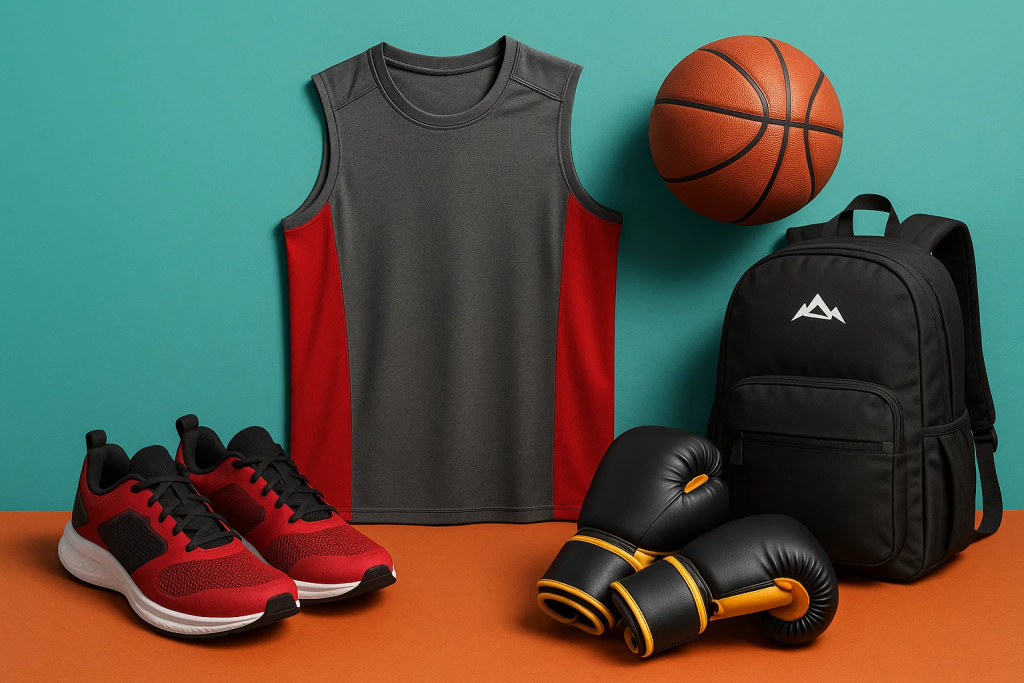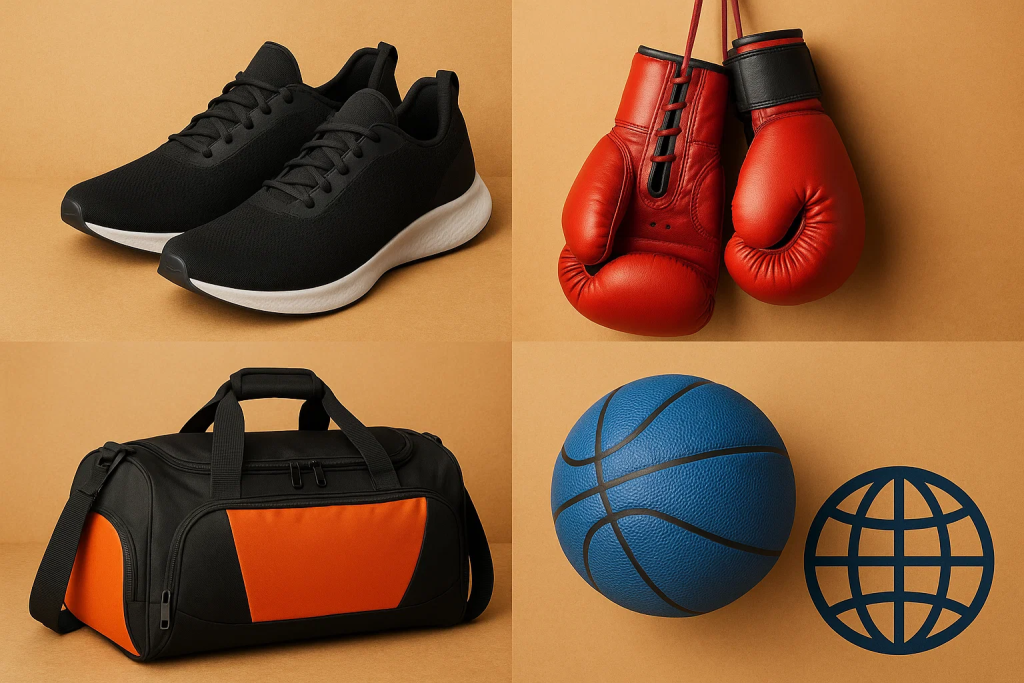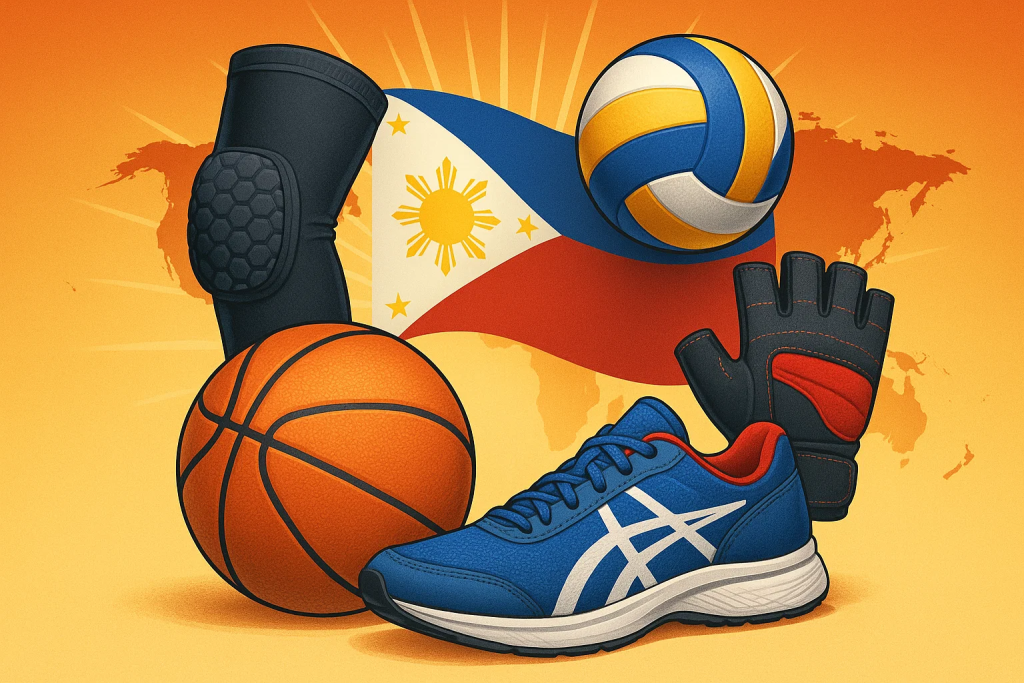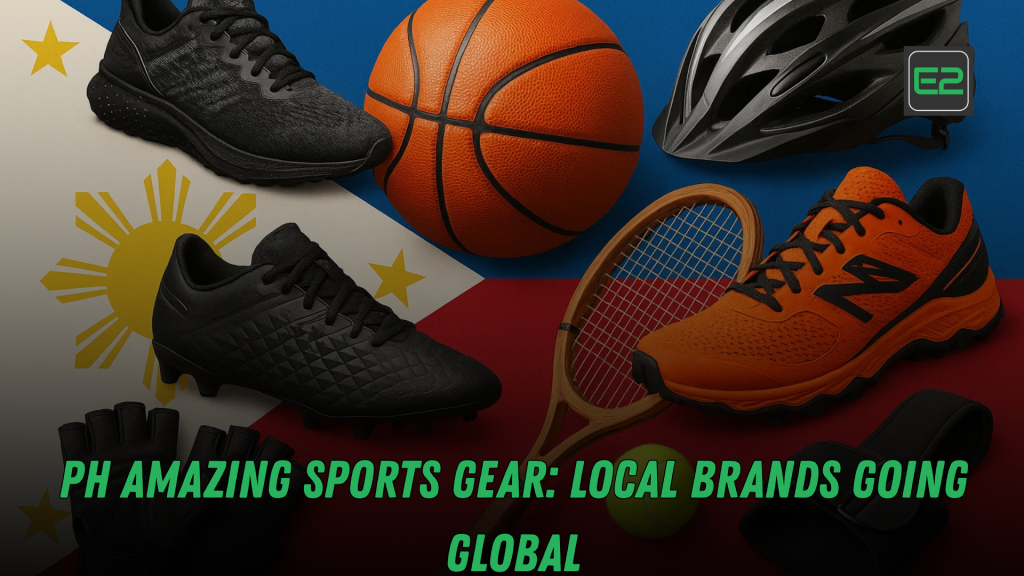Table of Contents
Why the Next Wave of Performance Comes from the Philippines
The Sports Gear Philippines is entering a golden window for product-led exporting. A generation of founder-builders, supply chains that blend artisan craft with flexible manufacturing, and the omnichannel rise of direct-to-consumer retail are converging into a new playbook. In that playbook, sports apparel, footwear, and performance accessories stand out—not only because the country is sports-obsessed, but because the ecosystem excels at precise stitching, soft goods engineering, and rapid prototyping.

For local brands, this is the moment to transform from neighborhood labels into regionally recognized companies. For international buyers, this is the moment to discover suppliers who can deliver reliable quality, fast lead times, and distinctive design. Throughout this guide we will use the phrase sports gear to anchor practical tactics for building a durable business that wins at home and abroad.
The Market Shift: From Recovery to Endurance
After a period of disrupted logistics and shifting consumer priorities, health and movement are now persistent behaviors. Weekly class bookings, community runs, and recreational leagues are translating into steady demand across categories. Consumers want versatile products that transition from training to commute to casual settings. They evaluate breathability, odor control, quick-dry performance, and ethical sourcing, but they also want clear sizing and transparent brand stories. Brands that meet these expectations in their sports gear lineups will not only sell more, they will be recommended more—a compounding loop of trust and word of mouth.
Why the Sports Gear in the Philippines Has an Edge
Localized craft with global sensibilities. Marikina’s long tradition of shoemaking and the archipelago’s cut-and-sew clusters create a deep bench of technicians familiar with performance stitching and compound materials. Agile minimums. Many workshops accept modest order quantities and can scale, which is ideal for iterative product-market fit in categories like compression layers, running shorts, or recovery sandals. Cultural proximity to key markets. ASEAN neighbors share climate conditions, body measurements, and style cues; the diaspora bridges North America and Europe. These factors make it easier to standardize blocks, size runs, and wear tests across multiple regions without losing cohesion in your sports gear range.
Five Consumer Insights That Move Revenue
- Fit and comfort beat aesthetics over time. Neatly finished seams, elastic recovery, and waistband grip determine whether a product becomes a weekly staple.
- Tropical performance matters. Fabrics that breathe and dry fast reduce friction in hot, humid cities and elevate perceived value.
- Versatility wins the closet. Cross-training silhouettes make one purchase viable for gym sessions, weekend trips, and casual wear.
- Local identity sells globally. Subtle motifs and palettes inspired by islands and cities add personality without sacrificing performance.
- Transparent value creates loyalty. Customers trust brands that disclose materials, labor practices, and care instructions.
Build these into your roadmap and you will see lower returns, higher repeat rates, and stronger reviews for your sports gear drops.
Product Design: From Sketch to Prototype to Launch
A durable roadmap separates average collections from breakout hits. Start with a concise range: a hero short, a breathable tee, a supportive bra, a multipurpose duffle, and a daily trainer. For each item, define a crisp purpose and a measurable metric. For example: target fabric air permeability above a specific value, minimum abrasion cycles before pilling appears, and a comfort score from wear testers. Your sports gear needs to articulate a clear point of view: fast-drying travel training, court-ready stability, or daily commuter-friendly performance.
Fabric and patterning. Use four-way stretch where mobility is critical, map mesh panels to heat zones, and position flatlock seams to avoid chafing. Conduct range-of-motion tests, then shorten or elongate patterns by millimeters until friction disappears. Hardware and details. Coil zippers with soft garages, reflective trims that survive washing, and durable drawcords are small decisions that signal quality. Inclusive sizing. Start with a pattern library that scales both width and rise. Publish an accurate size guide with body measurements in centimeters and inches. Consistency reduces returns and increases confidence in your sports gear brand.
Materials That Balance Performance, Cost, and Sustainability
- Recycled polyester (rPET). Lightweight, fast-drying, and widely available; blend with elastane for recovery.
- Nylon 6,6. Slick hand-feel and strong abrasion resistance; great for compression pieces and tights.
- Cotton blends. For lifestyle crossovers, add a small elastane percentage to retain shape without trapping heat.
- TPU and EVA foams. In footwear midsoles and insoles, dial durometer for cushioning versus energy return.
- Antimicrobial finishes. Use responsibly and disclose care instructions to maintain efficacy.
Suppliers should provide traceability and test certificates. Build a spec sheet for each component and keep a sample library. Season to season, small tweaks in yarn count or finishing can change hand-feel dramatically; guard consistency to sustain your sports gear reputation.
Quality, Compliance, and Lab Testing
Global expansion requires more than ambition. It requires paperwork and repeatable quality. Prepare for REACH, CPSIA, and Prop 65 where applicable, and set up a lightweight but rigorous internal testing regime:
- Colorfastness to washing and perspiration
- Dimensional stability after multiple launderings
- Tensile strength of seams and trims
- Abrasion cycles to pilling
- Odor retention across standardized wear tests
Archive results in a digital product passport for each item. When a buyer asks for proof, you have it. This diligence becomes a moat around your sports gear catalog in wholesale negotiations.
Pricing and Unit Economics That Actually Scale
Work backward from your target margin. Calculate cost of goods sold, landed cost, and tariffs to set a realistic MSRP. For direct-to-consumer, many founders aim for 65–70% gross margin to fund marketing and operations; for wholesale, expect a lower margin but higher volume. Bundle strategies—such as pairing a tee, short, and socks—lift average order value and help move inventory efficiently. Be transparent about shipping thresholds and returns. Clear math builds trust, and trust sells more sports gear without racing to the bottom.
Brand Storytelling: Islands to Arenas
Great brands compress meaning into a few consistent ideas. Consider a narrative that connects local craft to global aspirations: made for the islands, ready for every arena. Show the people behind the products, whether they are pattern makers, stitchers, or test runners. Let your visual system reference coastlines, sunrise gradients, or city grids—but keep it restrained and functional. When customers understand who you are and why you design the way you do, they care more about your sports gear and forgive small hiccups as you learn.
Channels and Merchandising: The Omnichannel Stack
- DTC site. Mobile-first, fast, and clear. Feature concise product pages with motion demos, fit notes, and laundering guides.
- Marketplaces. Start regionally with Shopee and Lazada, then test Amazon for cross-border reach.
- Retail partners. Gyms, academies, and running stores are credible launchpads. Offer co-branded capsules.
- Community events. Park runs, bootcamps, and intramural tournaments build grassroots traction.
Ensure your assortment has a hero, a supporting cast, and seasonal color updates. Too many SKUs create noise. A tight, disciplined shelf tells customers exactly which sports gear to buy first and why.
SEO and Content: The 90-Day Traction Plan
Days 1–30. Map a keyword cluster around fit, breathability, and size guides. Publish foundational articles and a glossary that demystify materials and care. Days 31–60. Add comparison content and troubleshooting guides (how to stop chafing, how to wash technical fabrics). Introduce brand stories and behind-the-scenes posts. Days 61–90. Produce case studies with coaches and micro-influencers, and publish training plans that integrate your products naturally. Use schema for products, FAQs, and reviews. When your content helps people move better, your sports gear benefits from authority and intent.
Social, UGC, and Community
Algorithmic feeds reward consistency and authenticity. Plan weekly pillars: product education, athlete spotlights, training tips, and cultural moments. Invite user-generated content with manageable challenges like a 14-day consistency sprint. Reward completion with discounts or early access. Feature repair and care tutorials to extend product life. Community stewardship builds an asset no competitor can copy: genuine affection for your sports gear.
Logistics, Sizing, and Returns
Cross-border commerce lives or dies on two things: delivery speed and sizing accuracy. Use two fulfillment nodes—one for ASEAN, one for North America or Europe—to keep average delivery under a week. Build a size table that maps height, weight, and waist to recommended fits; overlay customer feedback loops to continuously refine. Offer free or low-cost exchanges on first purchase to reduce hesitation. A painless exchange experience converts skeptics and upgrades the perceived value of your sports gear.
Legal, IP, and Counterfeit Defense
Register trademarks in core markets and monitor marketplaces for copycats. Watermark product images subtly and use distinct construction details that are difficult to mimic. Set up a takedown workflow and educate customers on how to spot fakes. Counterfeit prevention is brand protection; it secures perceived quality and pricing power for your sports gear line.
Sustainability That Customers Can Feel
Sustainability is credibility. Use recycled inputs where performance allows, reduce plastic in packaging, and disclose factory certifications. Offer a repair or refurbish program to extend life. Partner with local cleanups or sports-for-development groups and report outcomes, not slogans. Every measurable improvement compounds goodwill and differentiates your sports gear in crowded catalogs.
Metrics That Matter
- Repeat purchase rate and time between purchases
- Return rate with reasons categorized by fit, fabric, or defect
- Contribution margin after ad spend and logistics
- Organic traffic share and search rankings for core queries
- Engagement from real customers versus vanity metrics
Use these dashboards weekly. Adjust campaigns, sizing, and materials in response. When decision-making is disciplined, your sports gear improves every cycle.
A Four-Phase Launch Blueprint (120 Days)
Phase 1: Research and sketching (Days 1–30). Define the hero product and build tech packs. Source two fabric options, test hand-feel and stretch recovery, and assemble a wear-test squad.
Phase 2: Prototyping and testing (Days 31–60). Cut first patterns, iterate fit, and run heat-map sessions to place vents and reinforcements. Document modifications so the factory can replicate consistently.
Phase 3: Pilot and merchandising (Days 61–90). Produce a small batch, shoot motion photos, and pre-load the site with educational content. Prepare bundles that nudge customers toward complete outfits.
Phase 4: Launch and iterate (Days 91–120). Open with a community workout and an online waitlist. Offer a no-questions-asked exchange on first orders. Gather feedback and lock improvements before scaling. This patient ramp builds credibility and minimizes scrap, preserving margin and trust in your sports gear.

Case Patterns: What Success Looks Like
- Clear hero product. One signature short or tight pulls traffic and frames the brand’s intent.
- Fit tuned for climate. Patterns and fabrics made for humidity build word-of-mouth in tropical regions.
- Community-first merchandising. Co-created capsules with clubs and studios anchor local adoption.
- Relentless QC. Every batch is tested, every defect is logged, and replacements are frictionless.
When these traits align, growth compounds and customers advocate for your sports gear without prompting.
Common Mistakes (and How to Avoid Them)
- Launching too many SKUs. Focus on a small, excellent range before expanding.
- Ignoring size consistency. Customers punish inconsistent fits with returns and bad reviews.
- Outsourcing the entire story. If you don’t narrate your process, marketplaces will reduce you to price.
- Treating sustainability as theater. Publish real numbers and timelines.
- Skipping lab tests. Defects discovered post-launch are the most expensive kind.
Avoid these traps and you will conserve cash, protect morale, and steadily elevate your sports gear quality.
Call to Action: Start Small, Start Now
Pick one hero, one material stack, and one community to serve first. Document the build, test ruthlessly, and launch with a clear promise. Invite feedback and iterate in public. The combination of authentic storytelling and operational rigor is rare—and it wins. If you’d like a practical checklist, a sample tech pack, and a 90-day content calendar, join our newsletter today. The sooner you ship, the sooner customers can move better in your sports gear.
Email, Lifecycle, and Retention Engines
Retention is the quiet superpower of modern brands. Build a simple lifecycle that respects attention and delivers value. Start with a warm welcome series that introduces your founders, explains fabric choices, and sets expectations for care and longevity. Follow with post-purchase education—how to wash technical materials, when to rotate shoes, and how to log training gains. Every message should help customers get more from their sports gear, not just push another discount. Use triggered flows for size exchanges, low-inventory alerts, and anniversary milestones. When email treats people like members rather than prospects, your community grows by choice, and your sports gear earns a permanent spot in their routine.
Retail Execution: From Table to Try-on
Physical retail remains a powerful channel for discovery. Merchandising matters: keep tables clean, group outfits by activity, and ensure mirrors are flattering and well lit. Train staff to ask outcome-based questions—“What are you training for?”—and to diagnose fit quickly. Offer a mini movement test area so shoppers can squat, lunge, and jog in place. The faster someone feels confident in your sports gear, the faster they convert. Provide printed care cards and a QR code that links to size guidance and repair instructions. Treat every store visit as a workshop and every workshop as a community event; the goodwill flows back into your online channels.
Internationalization and Localization
Going global is a translation problem as much as a logistics problem. Audit your product names, descriptions, and size charts for clarity. Convert centimeters and inches; localize temperature and humidity advice for care. In multilingual markets, adapt the tone, not just the words. Partner with community coaches to validate fit and usage norms before you scale a new region. When customers feel that your site and packaging speak their language, they trust recommendations and adopt your sports gear faster. Localization also applies to imagery: show environments that reflect the customer’s city and culture without resorting to clichés.
Data, Analytics, and Merchandising Science
Data is a tool for empathy. Instrument your site and customer support so you can see why someone returns an item and how long it takes them to reorder. Track heatmaps on product pages, analyze search queries, and study cohort behavior after new color drops. Use these insights to right-size inventory, choose colorways, and phase out underperforming designs. A small dashboard reviewed weekly can prevent costly mistakes and optimize the release cadence for your sports gear. Where possible, share sanitized insights with factory partners so they understand the “why” behind change requests; collaboration accelerates quality.
Customer Service Playbooks That Create Advocates
Support is not a cost center; it is brand theater. Empower agents to resolve issues on first contact, and equip them with fit guidelines, fabric knowledge, and authority to authorize exchanges. Set response-time targets that reflect your promise, and publish them openly. Handle defects with gratitude—“Thanks for catching this; we’re fixing it immediately”—then follow with a tangible remedy. When shoppers experience thoughtful service, they tell friends, and those friends search for your sports gear on purpose. Close the loop by tagging every ticket with reasons and resolutions; those tags become inputs for design, sizing, and quality control.
Risk Management and Contingency Planning
Resilience comes from preparation. Map potential disruptions: fabric shortages, port delays, sudden demand spikes, influencer-driven runs. Create alternates for key materials and keep an emergency buffer for hero styles. Draft a communications plan for late shipments that offers proactive updates and choices—refund, store credit, or a ship-later bonus. In a crisis, truth and options build trust. Customers remember how you handle the hard days and continue choosing your sports gear after the dust settles.
Training Partnerships and Athlete Programs
Grassroots partnerships punch far above their cost. Equip community coaches with sample kits and ask for honest feedback. Design a test-and-learn program where athletes trial new fabrics during real sessions, then report on heat, friction, and recovery. Keep incentives simple: early access, limited-edition colors, and input into future design lines. These relationships provide a stream of actionable insights and genuine testimonials that elevate belief in your sports gear. When an athlete explains why a seam was moved or a pocket was reinforced, customers hear competence—and competence converts.
Care, Repair, and End-of-Life Programs
Make longevity a pillar. Publish care guides that explain detergent choice, water temperature, and drying methods by fabric type. Offer stitch repair or patch kits for common wear points like inner thighs or pack straps. Run a trade-in or donation program for gently used items and publish the outcomes in your impact reports. The longer your items last, the stronger the bond with your brand—and the better the economics of your sports gear over time.
Final Thoughts
Momentum favors brands that combine humility with excellent execution. Start with the smallest range that can prove your thesis, hold your standards when timelines compress, and reward the partners who show up when plans wobble. Treat every customer interaction as a chance to teach, repair, or cheer someone on. In the long run, the companies that obsess over fabric feel, fit consistency, care clarity, and honest storytelling will outlast louder rivals. Ship, learn, and keep promises—those are the habits that turn local labels into dependable companions for daily training and beyond.

Frequently Asked Questions
1) Which categories should a new brand test first?
Start with lightweight apparel, supportive basics, and one standout accessory. These items have strong demand, simpler sizing, and faster development cycles.
2) How do I keep quality consistent across factories?
Create a rigid spec library with tolerances, build pre-production samples for sign-off, and perform incoming inspections on every batch.
3) Is DTC better than marketplaces for new exporters?
Use a hybrid approach. DTC tells your story and collects first-party data; marketplaces provide reach and social proof.
4) What margin should I target?
For DTC, 65–70% gross margin funds growth. For wholesale, work backward from retailer expectations and your cost base to maintain profitability.
5) How can I protect my designs?
Register trademarks early, document unique construction details, and maintain a rapid release cadence so you’re always one step ahead.
